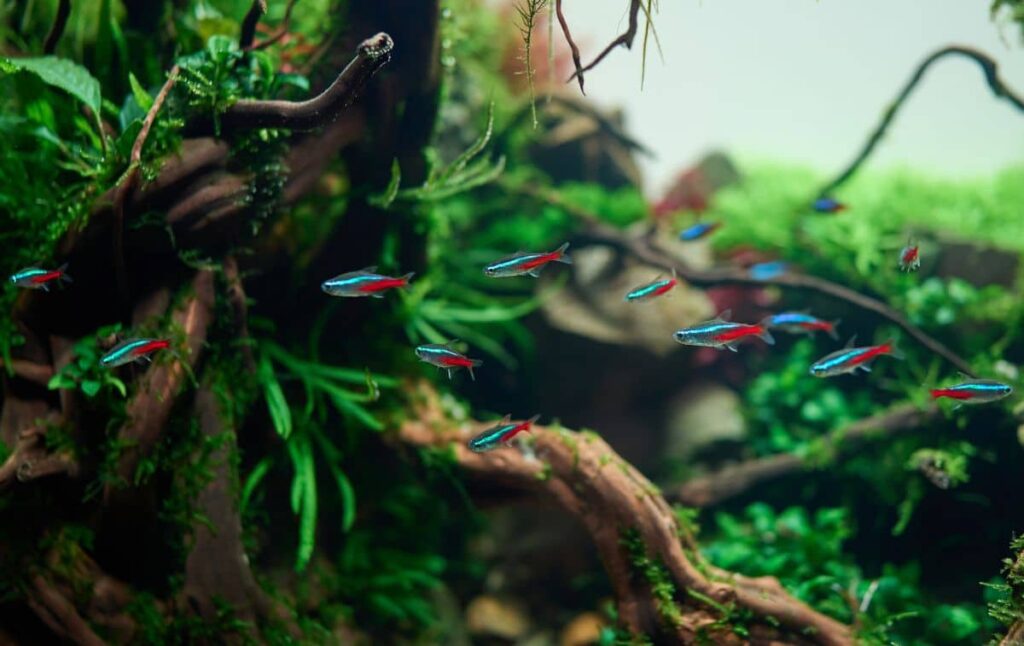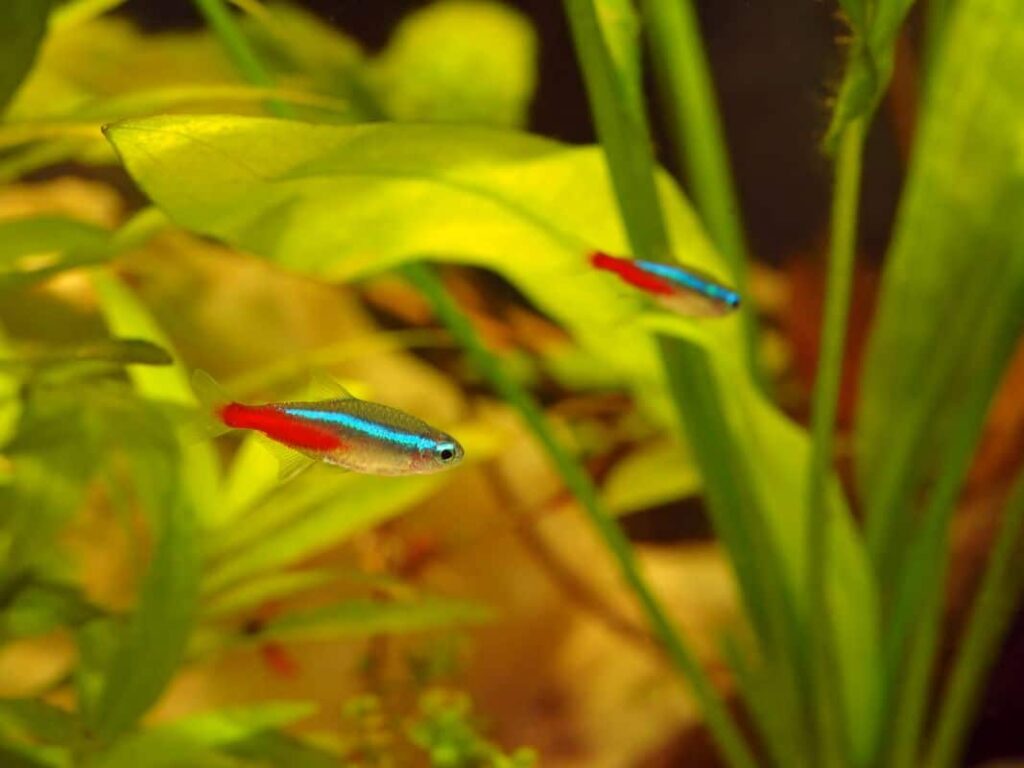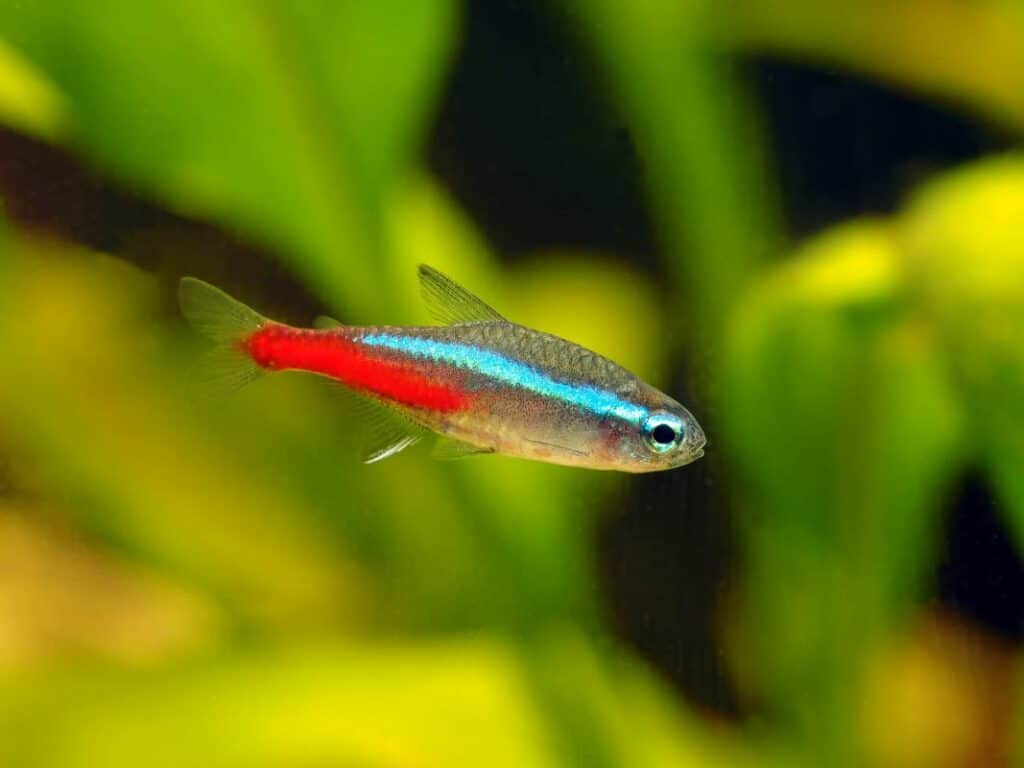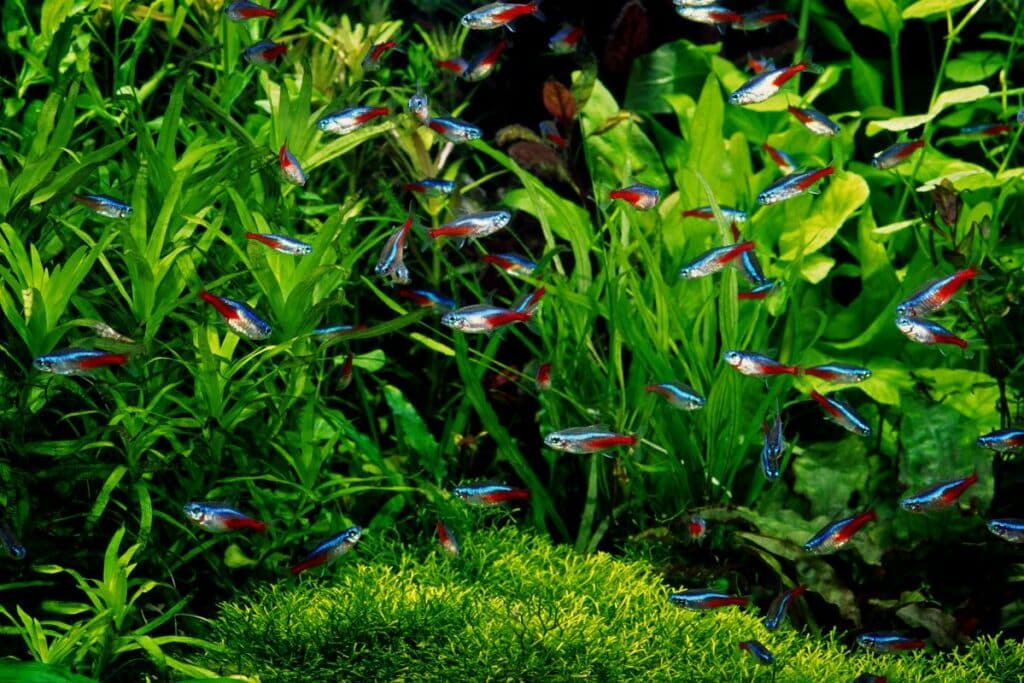the essentials in brief
It is recommended to keep at least 6-8 neon tetras in the aquarium to ensure appropriate social behavior and a swarm effect.
Neon tetras are peaceful fish and can be socialized well with other peaceful fish species that prefer similar water conditions. Find out more about the care and keeping of neon tetras here...
About 200-20 neon tetras can be kept in a 25 liter aquarium. This is based on the recommendation of around 6-8 neon tetras per 60 cm of aquarium length. Discover more information about neon tetras here...
are neon tetras colorful and lively freshwater fish, known for their bright colors and peaceful character. But where do these fascinating little fish actually come from and what does their natural habitat look like? In this blog post we will deal in detail with the origin and habitat of the neon tetra and give an insight into their original environment.
Origin and habitat of neon tetras

The neon tetra (Paracheirodon innesi) comes from the tropical waters of South America. They originally come from the tributaries of the Amazon, more precisely from the countries of Brazil, Colombia and Peru. They were first discovered in the 1930s and have since found a permanent place in aquaristics.
The natural habitat of the neon tetras are the clear, slow-flowing waters of the Amazon rainforest. There they inhabit small rivers, streams and floodplains with dense vegetation. The water in these areas is warm and soft with a slightly acidic pH.
In their natural habitat neon tetras live in large swarms, which can include hundreds of animals. These swarms offer them security from predators and enable them to search for food efficiently. The fish stay mainly in the middle and upper water zone and use the dense vegetation as a hiding place and spawning ground.
The waters in which neon tetras live often have a natural daylight cycle that plays an important role in their behavior and reproduction. The males are particularly active at dusk and display their impressive bright blue coloration, which they use for courtship and communication with other fish.
In order to reproduce the natural habitat of the neon tetra in the aquarium, it is important to create certain conditions. The Water should be slightly acidic (pH between 6 and 7) and soft, at a temperature of about 24-26°C. Sufficient planting with floating plants and hiding places in the form of roots or caves are also important.
Neon tetras are peaceful fish, which can be kept well in an aquarium with other peaceful species such as dwarf shrimp, dwarf gouramis or dwarf cichlids. However, it is important not to keep them with larger or aggressive fish species as they can be easily intimidated.
Terminology
Did you know that neon tetras were named after the light? They were named after the famous neon lights that became popular in the 1930s. The bright colors of the neon tetras reminded the discoverers of the glaring neon light and this is how the fish got their name. A fitting homage to their impressive blaze of colour!
Types of neon tetras

Neon tetras are popular freshwater fish that can be found in many aquariums because of their bright colors and peaceful nature. But in addition to the well-known classic neon tetra (Paracheirodon innesi), there are also other fascinating speciesthat need to be discovered. Below we present some of the most interesting neon tetra species and their special features in detail.
- Classic neon tetra (Paracheirodon innesi): The classic neon tetra is probably the most well-known species of this fish family. It is distinguished by its bright blue and red stripes from head to tail. The classic neon tetra is peaceful, sociable and ideal for community aquariums. It prefers soft, slightly acidic water with a temperature of 22 to 26 °C.
- Cardinal neon tetra (Paracheirodon axelrodi): The cardinal neon tetra is similar to the classic neon tetra, but is slightly larger and more conspicuously red in color. The red stripes run all over the body and give it an impressive look. Cardinal neon tetras are also peaceful and require similar water conditions as their classic relatives.
- Green neon tetra (Paracheirodon simulans): The Green Neon is a smaller and lesser-known species that is often overlooked. It is characterized by its bright green and blue stripes that give it a unique look. Green neon tetras are just as peaceful as other species and can be socialized well with other peaceful fish species. They also prefer soft, slightly acidic water.
- Black neon tetra (Hyphessobrycon herbertaxelrodi): The black neon clearly differs from the other species due to its dark, almost black color. It has a bright blue stripe down its sides and a red stripe at the end of its tail. Black neon tetras are a bit more robust than other species and can also be kept in somewhat harder water. They prefer temperatures between 23 and 27 °C.
- Blue neon tetra (Paracheirodon simulans): The blue neon tetra is a variant of the green neon tetra with an intense blue coloration. Its blue stripes shine in bright colors and make it an eye-catcher in the aquarium. Blue neon tetras have similar water requirements as other neon tetra species.
Tip: Neon tetras are schooling fish and feel most comfortable in groups. Keep at least XNUMX to XNUMX neon tetras to keep them safe. A good crush reduces stress and encourages their natural behavior. Make sure that the number of fish corresponds to the size of your aquarium.
Magnificent colors and luminous behavior of neon tetras
Neon tetras are not only known for their peaceful nature, but also for their impressive display of colors and lively behavior. The luminous stripes along her body make her a real eye-catcher in the aquarium. In the following we delve deep into the fascinating world of the colors and the luminous behavior of the neon tetras and explore the background of their spectacular appearance.
colourfulness
The blaze of color of the neon tetra is a real feast for the eyes. Their bright stripes in bright blue, bright red and sometimes bright green make them one of the most colorful fish species in freshwater aquariums. Are responsible for the intense colors special cells in the skin the so-called chromatophores. The interaction of these cells creates the distinctive stripes that make neon tetras so unique.
Luminous behavior
Neon tetras are not only colorful, but also known for their luminous behavior. In certain situations, e.g during courtship or when excited, they show a more intense glow. The bright blue along the sides of the body is particularly emphasized and attracts the attention of other fish. This behavior is used for communication within the species and can also serve as a warning signal to potential predators.
The reason for this lighting behavior are special cells, so-called light-emitting diodes or photophores, which are located in the skin of the neon tetra. These cells can generate light and be activated by certain stimuli. The luminous behavior of the neon tetra is not only beautiful to look at, but also fulfills important functions in its natural habitat.
In the aquarium
In order to bring out the colors and the lively behavior of the neon tetras in the aquarium, it is important to ensure optimal conditions. This includes a balanced diet, regular water care and appropriate social behavior in the aquarium. Neon tetras feel comfortable in well-planted aquariums with sufficient hiding places. Subdued lighting can help her colors stand out better.
Additional information: If you want more information about the care and keeping of neon tetras, you can consult specialist books on aquaristics, aquaristic websites or aquaristic forums.
Care and keeping of neon tetras

Neon Tetras are popular and fascinating freshwater fish known for their bright colors and peaceful demeanor. In order to offer them optimal well-being, the right care and attitude is important. In this blog article we will give you one detailed guidelines for the care and keeping of neon tetras, so you can enjoy a healthy and happy aquarium with these wonderful fish.
aquarium setup
Suitable aquarium equipment is of great importance for neon tetras. An aquarium at least 60 cm long offers enough space for a swarm neon tetra. Good planting with dense vegetation offers hiding places and creates a natural environment. Floating plants or floating layers can filter the light and give the fish a sense of security.
water parameters
Neon tetras prefer soft water with a slightly acidic pH. The ideal pH is between 6,0 and 7,0. The Temperature should be between 22 and 26 °C. Regular water changes and water quality control are important to ensure optimal conditions. It is advisable to use a water conditioner to neutralize pollutants in tap water.
Feeding
Neon tetras are omnivores and will eat a variety of foods. A varied diet with high-quality dry, frozen or live food is recommended. Fine flake food, microgranules or special tetra food are well suited. Only feed as much as the fish can eat in a few minutes to avoid overfeeding and water pollution.
social behavior
Neon tetras are schooling fish and feel most comfortable in groups of at least six to eight animals. A good crush gives them security and reduces their stress levels. neon tetra should be socialized with peaceful fish species of similar size, to minimize conflict and stress. Avoid aggressive fish or fish that are too big, as these can harass the neon tetras.
health care
Regular observation of neon tetras is important in order to recognize signs of disease at an early stage. Watch for behavioral changes like Loss of appetite, abnormal scales, abnormal swimming behavior or signs of parasitic infestation. If a disease is suspected, it is advisable to consult a veterinarian or a specialist dealer who is familiar with fish diseases.
Note: Neon tetras are sensitive fish that depend on good water quality. Therefore, make sure you change the water regularly and keep the water values constant, such as pH and temperature. Use a quality water conditioner to neutralize pollutants. Good water quality is crucial for the well-being and health of your neon tetras.
Summarized neon tetras
Neon tetras originate from the tropical waters of South America and inhabit the Amazon rainforest. Their natural habitat is clear, slow-flowing water with dense vegetation. By creating similar conditions in the aquarium, the aquarist can admire the beauty and natural behavior of these fascinating fish. Proper care and socialization is importantto ensure the fish live a healthy and happy life in captivity.

